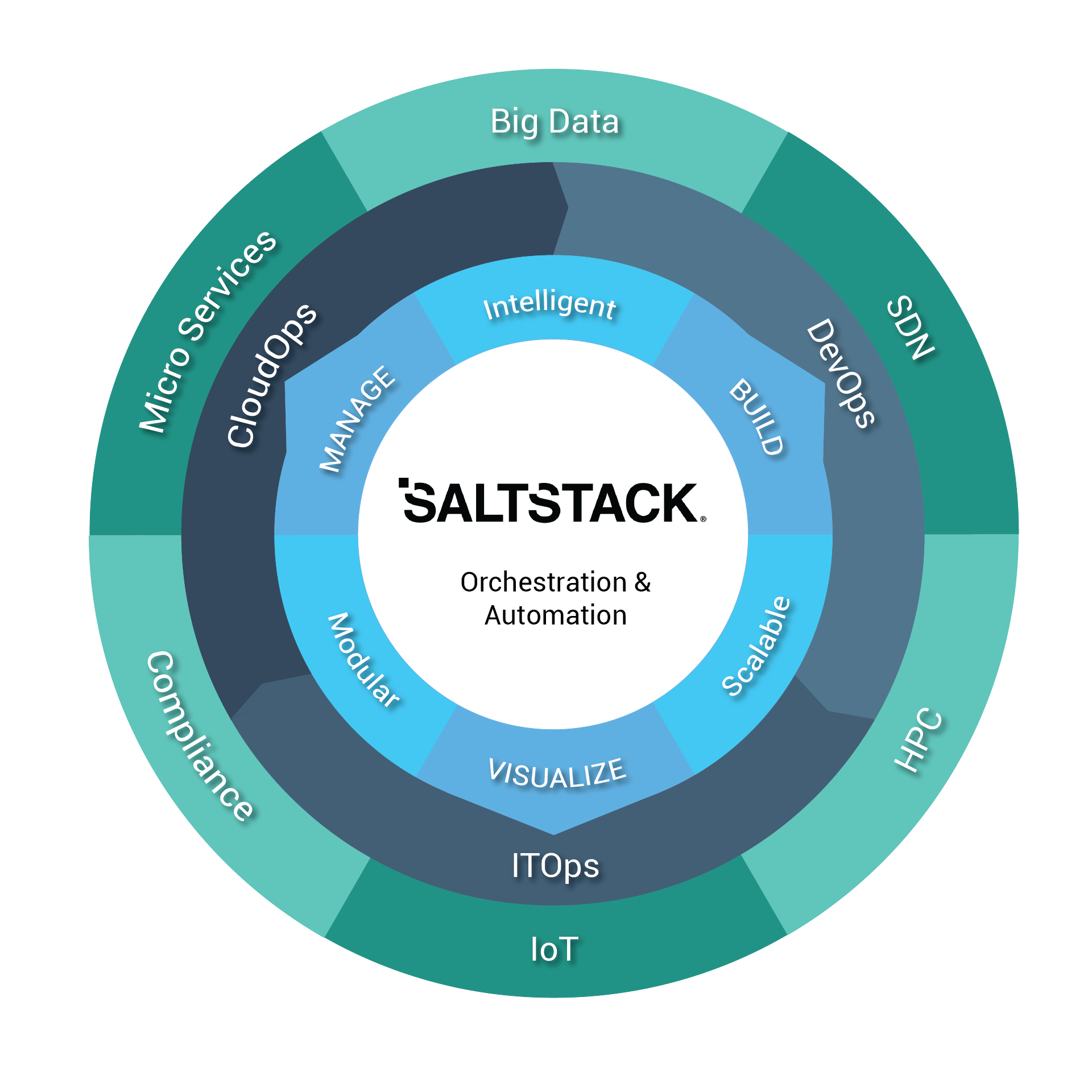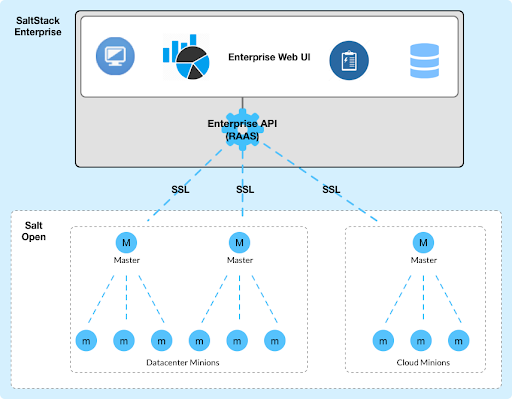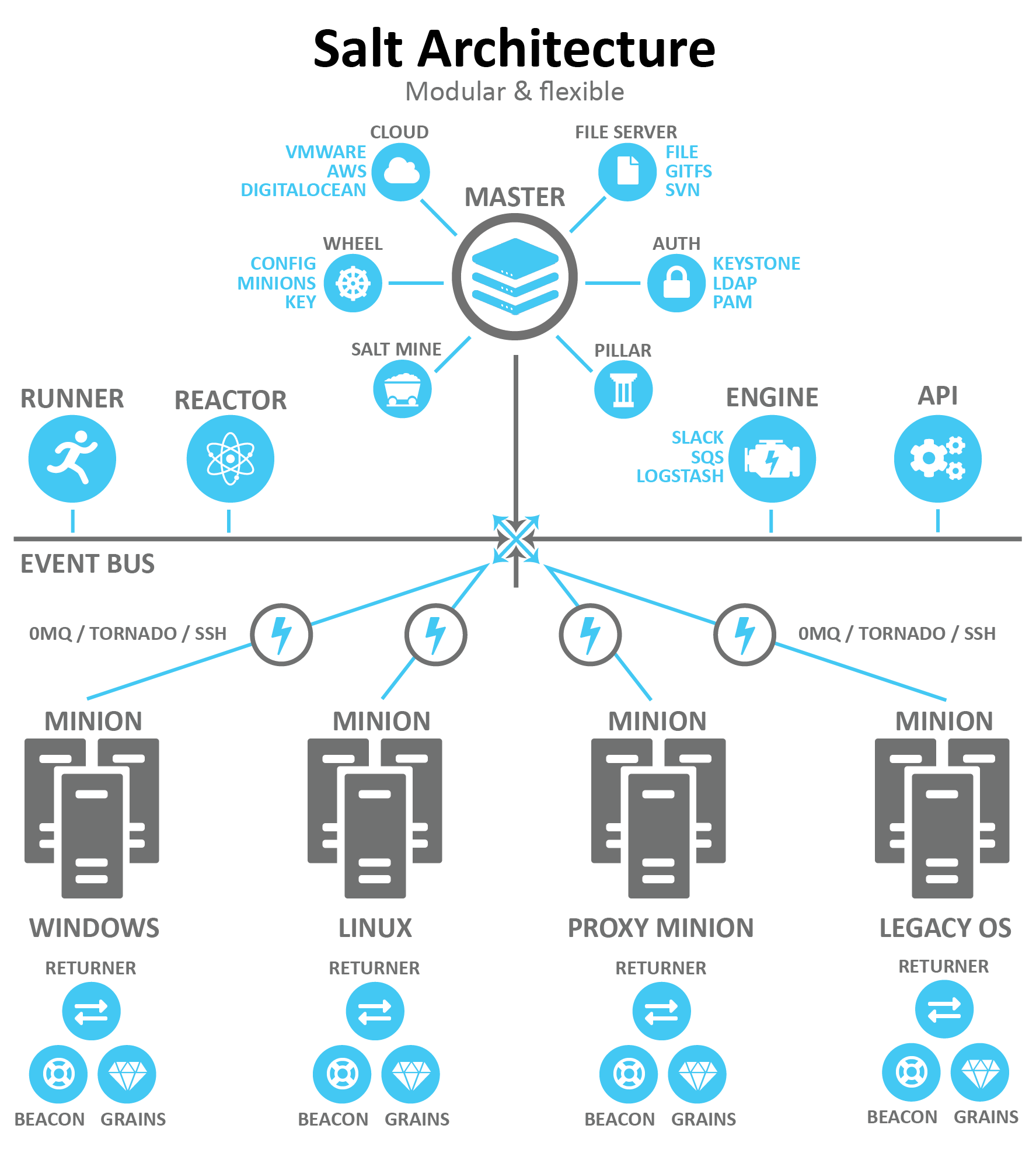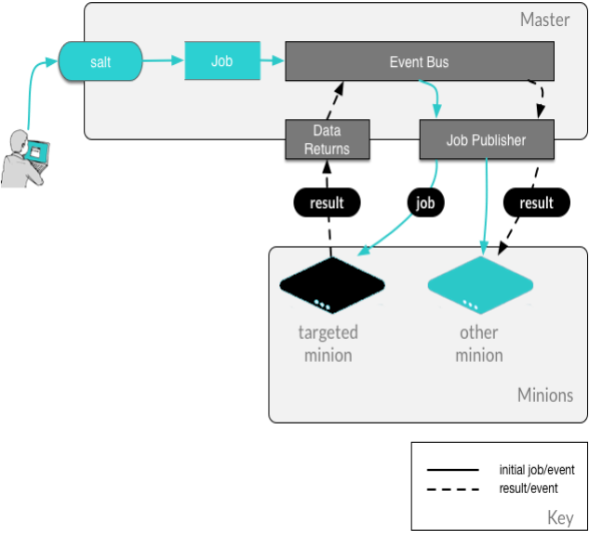Salt overview¶
Features of Salt¶
The Salt system is a Python-based, open-source remote execution framework for configuration management, automation, provisioning, and orchestration.

Salt delivers a dynamic communication bus for infrastructure to leverage in:
Remote execution.
Configuration management.
Automation and orchestration.
Salt supports the Infrastructure as Code approach to deployment and datacenter management.
Remote management¶
Running commands on remote systems is the core function of Salt. Salt can execute multiple commands across thousands of systems in seconds with a single execution.
Configuration management¶
The Salt configuration management system is based on storing all configuration or “state” data inside an easily understood data structure. The concept behind the State system is:
Simple - easy to administer and manage.
Extensible - easy to add custom modules, or extend existing states.
Deterministic - executes in the same way every time.
Layerable - provides layers of data abstraction (such as states calling execution modules).
Automation and orchestration¶
Executing remote management and configuration on a system is perfect when you want to ensure that it is configured and running the way you want. Sometimes, however, you want to configure a set of systems at once. For example, if you want to set up a load balancer in front of a cluster of web servers, you can ensure the load balancer is set up first. You can then apply the same matching configuration consistently across the whole cluster, which is known as orchestration.
Salt management concepts¶
A basic Salt implementation consists of a Salt master managing one or more Salt minions.
Salt master¶
A server running the salt-master service is a Salt master. The master
provides a cohesive platform for orchestration and automation between managed systems.
Salt minion¶
A Salt minion is any system or device managed by Salt. A minion can either run the
salt-minion service or be agentless using salt-ssh or salt-proxy.
A minion running the service may execute commands without a master in stand-alone
mode.
Salt proxy¶
A Salt Proxy is used to execute commmands on devices that are unable to run the minion service. The proxy minion receives commands from a master, translates and transmits the commands appropriate to the method of connection to the underlying device (SSH, REST, etc.), and relays the results back to the master.
Salt SSH¶
The Salt SSH system was added as an alternative means to communicate with minions. It does not require that a minion be present on the target system, only that the SSH service is running and port 22 is open.
SaltStack Config¶
SaltStack Config provides an intuitive user interface to perform complex functions like configuration management and orchestration. Jobs in SaltStack Config can be built, stored, and scheduled so you spend less time and fewer resources executing routine functions. It also allows distributing the work to other skill-level employees and teams while securing your system and guarding the environment from the misuse of powerful tools.

SaltStack Config features include:
A web-based user interface
Role-based access control
Multi-master support
Central job and event cache
LDAP, SAML, OIDC, & Active Directory integration
Security policies with industry-standard compliance profiles, such as CIS and DISA STIGS
Reporting
An enterprise API (eAPI)

Salt topology¶
Salt has two ports used by default for the minions to communicate with their master. These ports work in concert to receive and deliver data to the Message Bus. Salt’s message bus is ZeroMQ, which creates an asynchronous network topology to provide the fastest communication possible.
Open event system¶
The event system is used for inter-process communication between the master and minions:
Events are seen by both the master and minions.
Events can be monitored and evaluated by both.
The event bus lays the groundwork for orchestration and real-time monitoring.

Salt event system execution architecture¶
All minions see jobs and results by subscribing to events published on the event system. Salt uses a pluggable event system:
ZeroMQ (0MQ) - the current default socket-level library providing a flexible transport layer.
Tornado - full TCP-based transport layer event system.
High-speed communication bus¶
One of the greatest strengths of Salt is the speed of execution. The event system’s communication bus is more efficient than running a higher-level web service (such as HTTP). The remote execution system is the component that all components are built upon, allowing for decentralized remote execution to spread load across resources.
YAML Salt configuration file format¶
YAML Ain’t Markup Language is a human friendly data serialization standard for all programming languages. It is not a markup language like XML which uses tags to “mark” text. YAML commonly focuses on data structures, such as lists and dictionaries, not document markup.
Rules of YAML¶
The default renderer for many of the files used in Salt is the YAML renderer. YAML is a markup language with many powerful features. It is the job of the YAML renderer to take the YAML data structure and compile it into a Python data structure for Salt.
There are basic rules for creating YAML:
Data is structured in
key: valuepairs.Mappings use a colon and one space (“: ”) to mark key: value pairs.
The value of keys can be in many different structures.
All keys/properties are case-sensitive.
Tabs are NOT allowed, use spaces ONLY.
Comments begin with a hash “#”.
YAML simple structure¶
YAML consists of three basic element types:
Scalars -
key: valuemappings where the value can be a number, string, or boolean value.Lists - a
key:followed by a list of values where each value is on a separate line and proceeded with two spaces and a hyphen.Dictionaries - a collection of
key: valuemappings and lists.
Note
All keys are case sensitive.
Scalar
# key: value
vegetables: peas
fruit: apples
grains: bread
Lists
# sequence_key:
# - value1
# - value2
vegetables:
- peas
- carrots
fruits:
- apples
- oranges
Dictionary
dinner:
appetizer: shrimp cocktail
drink: sparkling water
entree:
- steak
- mashed potatoes
- dinner roll
dessert:
- chocolate cake
Lists and dictionaries - YAML block structures¶
YAML is organized into block structures.
Indentation sets the context. You MUST indent your properties and list with one or more spaces, but two spaces is standard.
A collection, which is a list, or dictionary block sequence, indicates each entry with a hyphen and a space (“- ”).